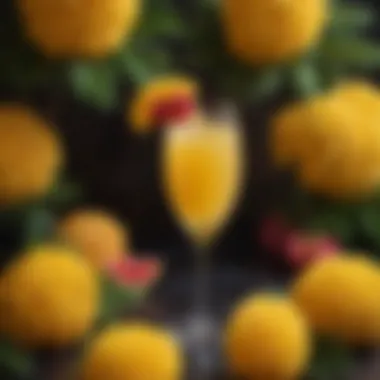Crafting Exquisite Mimosas with Champagne: A Guide


Intro
Mimosas are an elegant and popular cocktail often enjoyed during brunch or special occasions. Crafted with a combination of champagne and fruit juice, they offer a refreshing quality that pleases the palate. While seemingly simple, the art of crafting a perfect mimosa involves a deeper understanding of ingredients, preparation techniques, and possible variations. This guide aims to deep-dive into the complete landscape of mimosas using champagne, ensuring readers attain a mastery of this classic beverage. From the selection of top-quality ingredients to serving methods, we strive to enhance both the cocktail making skills and appreciation for this drink.
Ingredients Breakdown
Crafting the perfect mimosa begins with selecting the right ingredients. Each component plays an essential role in flavor, quality, and presentation.
Primary Ingredients
- Champagne: The primary ingredient, champagne, serves as the base. Choose a dry variety, such as Brut or Extra Brut, to balance the sweetness of the juice.
- Fruit Juice: Traditional mimosas are predominantly made with orange juice, though other fruit juices can be delightful as well. Some enthusiastic makers prefer fresh-squeezed juice for a more vibrant flavor.
Optional Ingredients
In addition to the primary components, some optional ingredients can elevate the drink:
- Liqueurs: Add a splash of fruity liqueur like Peach Schnapps or Grand Marnier for extra depth.
- Herbs and Spices: Fresh mint or a dash of nutmeg can introduce a unique twist to your mimosa.
- Garnishes: Consider pieces of fresh fruit, berries, or a twist of citrus peel for visual appeal.
Essential Kitchen Tools
To create a stellar mimosa, a few basic tools are advantageous:
- Wine Glasses: Select slender fluted or tulip-shaped glasses to concentrate bubbles and preserve carbonation.
- Juicer: A manual or electric juicer simplifies extracting juice from fresh fruit.
- Bar Spoon: Useful for stirring gently without losing bubble retention.
Step-by-Step Preparation
Preparation is key when it comes to crafting the ideal mimosa. To create a seamless process, adhere to the following guidelines.
Prepping the Ingredients
Begin by chilling your champagne in advance. Here are some preparation steps:
- Juice the fruit. Fresh is always best, so using a juicer improve flavor. Straining the juice helps to achieve clarity.
- Chill your glasses preemptively in the refrigerator to enhance diner experience with a colder drink.
Cooking Techniques and Methods
Cookings techniques may not seem directly apply, but the way you combine ingredients matters:
- Pour juice first: This helps to dictate the ratio of champagne to juice, vital in achieving consistency.
- Add champagne slowly: Pour gently down the side of the glass or over a spoon to maintain carbonation.
Assembly and Presentation Tips
The assembly process completes the drink:
- Employ a gentle stir with a bar spoon.
- Float a garnishing fruit on top for visual clash.Choose glassware that best enhance presentation.
Prolusion to Mimosas
Mimosas are more than just a beverage for brunch; they embody a ritual of leisure and celebration. As an elegant yet simple mix of champagne and orange juice, understanding mimosas is crucial for appreciating their appeal. This section will delve into why knowledge of mimosas enriches one’s culinary experience and makes cocktail crafting enjoyable and refined.
Understanding the Mimosa
A mimosa is a unique cocktail that often serves as a delightful start to special occasions. The concoction traditionally comprises equal parts of champagne and freshly squeezed orange juice. Its balance satisfies both the palate and the spirit. This refreshing drink is characterized by vibrant hues of orange and the effervescence of champagne, making it visually appealing as much as flavorful. Key benefits of crafting mimosas include versatility in serving and ease of preparation, enabling anyone to master this classic drink.
Historical Background
The origins of mimosas can be traced to the early decades of the 20th century. Some sources suggest that the mimosa was first mixed in the Buck’s Club in London around 1925. However, the drink has continued to evolve throughout history, embracing regional variations and adaptations. It soon became associated with leisurely brunches and celebrations.
The cultural impact of mimosas is notable. They often add a touch of sophistication to gatherings, frequently featured at bridal showers, weddings, and festive brunches. Understanding this history adds depth to the knowledge of mimosas as it connects this beverage not just with recipes, but also with the rituals it signifies in various social contexts.


Selecting Ingredients
Selecting the right ingredients is paramount when crafting mimosas with champagne. Each component contributes not only to the flavor profile of the drink but also to its overall quality and presentation. Understanding the subtleties involved in ingredient selection will elevate your cocktail-making skills and ensure a rewarding experience for both the maker and the consumer.
Choosing the Right Champagne
Champagne is perhaps the most significant ingredient in a mimosa, establishing its foundation. Selecting a suitable champagne requires consideration of both flavor and type. The market offers a wide range of options, including
- Non-Vintage Champagne: Generally more affordable and approachable. Often crisp with fruit character.
- Vintage Champagne: Made from grapes of a single year, showcasing distinctive features. Priced higher but offers depth.
- Sparkling Wine: Options from other regions like Prosecco or Cava are viable but differ in taste.
When choosing champagne, look for a fresh and tangy flavor. A blend of Pinot Noir, Pinot Meunier, and Chardonnay is often preferred for mimosas, as these offer a balance between acidity and structure. Ultimately, the goal is to enhance the sparkle without overwhelming the vibrant taste of orange juice, which leads to the importance of becoming familiar with varying characteristics of different champagnes.
Quality of Orange Juice
Orange juice serves a dual purpose in mimosas: it adds sweetness and acidity while reinforcing the champagne’s effervescence. To achieve the best results, focus on quality. Freshly squeezed orange juice is always optimal. Its bright flavor is unparalleled. Processing orange juice often diminishes the essential oils and flavors inherent to the fruit. Plus, fresh juice contributes significantly to the unique profile of individual mimosa creations. When juicing oranges:
- Choose ripe, sweet oranges: Navel oranges are popular—low in acidity and high in sweetness.
- Juice immediately before serving: Freshness is vital.
- Taste as you go: This ensures a well-balanced drink that works best with your chosen champagne.
Optional Flavor Enhancements
For those who wish to experiment beyond the basics, several optional flavor enhancements can amplify the traditional mimosa experience. These additions open the door to creativity while applying an individualized touch. Consider:
- Fruit Purees: Strawberry, raspberry, or peach purees can easily elevate flavors.
- Liqueurs: A splash of Grand Marnier or Chambord can add complexity.
- Herbs and Spices: Muddle fresh mint or basil for a fresh twist.
- Flavored Syrups: Lavender or vanilla syrups can transform your drink.
Implementing these enhancements requires careful consideration and balance to enhance, rather than overshadow, the drink’s integrity.
Always keep personal preference in mind; license for creativity ultimately enriches the mimosa experience while also catering to varying tastes.
Overall, focusing on selecting high-quality champagne and juice, along with thoughtful flavor additions, sets the stage for a memorable mimosa. Engage actively with every part of the process, as this creates a delightful experience that is worth deriving joy and satisfaction from crafting great beverages.
Preparing the Ingredients
Preparing the ingredients is a crucial step in crafting an exquisite mimosa. This phase highlights the importance of freshness and quality. The process involves choosing the right fruits and properly managing the champagne to enhance the overall taste. Not only can it dictate the flavor of the drink, but it can also impact its visual appeal.
Juicing Fresh Oranges
The choice of oranges is paramount. Freshly juiced oranges add a vibrant zing that packaged juices cannot provide. To juice fresh oranges, select Valencia or navel oranges for a perfect balance of sweetness and acidity.
- Begin by choosing ripe oranges. Look for those that are slightly soft to the touch and rich in color.
- After selecting your oranges, wash them thoroughly.
- Cut each orange in half and use a citrus juicer to extract the juice.
- Strain the juice to remove any pulp if a smoother texture is desired. This makes the drink more refined.
Always aim for freshly squeezed juice when making mimosas. Doing so not only elevates the drink's quality but also ensures such a drink reflects freshness and care.
Chilling Your Ingredients
Temperature plays a key role in crafting a pleasant mimosa experience. Chilling both the champagne and the orange juice already enhances flavor. Here are some steps to ensure that your ingredients are properly cooled before mixing:
- Place both the champagne and the orange juice in the refrigerator at least a couple of hours prior to serving.
- Alternatively, if you are short on time, an ice bucket can work efficiently.
- Fill the bucket with ice and surround the bottles in ice for about 20-30 minutes, maintaining a desireable chill.
Keep in mind, serving mimosas too warm can result in a flat drink. A well-chilled mimosa, however, invigorates the palate and delivers a high-quality drinking experience.
Mixing the Mimosa
Mixing the mimosa is a crucial step that transitions high-quality ingredients into a delectable drink. It is not merely about combining orange juice with champagne; it involves a thoughtful approach to achieve balance and enhance flavor. The art of mixing significantly influences the drink's texture and overall enjoyment. Understanding the traditional expectations and personal preferences helps craft a better mimosa that pleases the palate.
The Classic Ratio
What is often referred to as the classic mimosa ratio typically consists of equal parts champagne and orange juice. This 50/50 mixture results in a refreshing and well-rounded beverage. However, some may argue that a slight change to the ratio, perhaps favoring champagne, adds depth without overwhelming the flavors of orange juice. Here are several key considerations:
- Flavor Balance: The ratio greatly affects how sweet or dry the drink turns out. A 1:1 ratio maintains a balance, while increasing the champagne can result in a dryer finish.
- Bubbly Characteristics: The effervescence of the champagne is important. Using the right amount, achieves the right amount of bubbles, contributing to that desired spritz.
- Personal Preference: Adjusting the ratio to your liking is totally acceptable, as some may prefer a more citrus-forward drink while others will want the wines complexity to shine.
Ultimately, exploration of the ratio can lead to discoveries of new gradients of flavor. Experimenting is encouraged.


Blending Techniques
Blending the components of a mimosa is an often overlooked but essential detail for producing a delightful experience. Attention to how you combine the ingredients matters for both flavor and texture. Here are effective techniques:
- Layering: Pour the orange juice first and then gently add champagne. This technique helps maintain the bubbles of the champagne right until the first sip, ensuring freshness.
- Swirling: After combining the ingredients, a gentle swirl of the glass can help to integrate the flavors without risking the champagne’s bubble integrity.
- Glass Preparation: Using a chilled glass can elevate the mimosa experience and enhance the freshness and crispness of the drink.
Employing these techniques may improve the celebration of mimosa and ensure every sip maintains delightful character.
Remember, the secret to a perfect mimosa starts before mixing: quality ingredients and an appreciation for balance lead to the best results.
Serving Mimosas
Serving mimosas is often seen as the finishing touch to the cocktail-making process. The presentation and choice of glassware can elevate the drinking experience, making it both enjoyable and memorable. Understanding the nuances of serving this classic beverage is crucial for ensuring that your mimosas resonate well with your guests. Important factors include the significance of glass types, optimal garnishing techniques, and artistic presentation that transforms your drink into an attractive centerpiece.
Selecting the Appropriate Glassware
The choice of glassware holds a crucial place when serving mimosas. While traditional champagne flutes are popular, they are not the only option. The glass's shape can influence both the look and the drinking experience of your mimosa.
A well-known choice is the champagne flute. Its narrow body preserves carbonation, highlighting the effervescent nature of champagne. However, if you seek a more relaxed approach, a coupes can provide a feeling of elegance and nostalgia. Coupe glasses have a wide bowl which gives space for a whimsical presentation.
On another side, tall tumblers work quite well, especially for fruit-infused mimosas. These glasses offer fuller volume allowing for varied layering possibilities. The rise of options in glassware gives hosts the freedom to adapt their service style based on occasion, making every gathering unique.
Keep in mind that the glassware should be clean and preferably chilled before serving. It helps maintain temperature, keeping the mimosa refreshing until consumed. Colorful glassware or stemless options can also ignite personal style, making every serving special and tailored to your taste.
Garnishes and Presentation
Garnishing is more than just beautifying the drink; it plays a role in enhancing the flavor profile and overall experience. When you serve mimosas, depending on the season or theme, you can incorporate complementary garnishes.
One of the common garnishes is fresh fruits like orange wedges or berries. These not only add visual appeal but also contribute subtle flavors that engage the palate. You might also consider using herbs like mint, which add a refreshing aroma when placed atop.
For finishing touches:
- A twist of citrus peel can give an aromatic boost.
- A sprinkle of edible flowers adds elegance to any approach.
Presentation is key, whether you aim for minimal simplicity or a lush display. Include special serving trays or boxes crafted for cocktails. Arranging the glasses with garnishes neatly can set the mood and make sure guests feel pampered.
Remember, each mimosa served is an introduction to hospitality. Your care in selecting glassware and garnishing impacts guest previews and satisfaction.
Exploring Variations of Mimosas
Exploring different variations of mimosas is not only an enriching culinary exercise but also a way to tailor this classic beverage to individual tastes and occasions. Each variation allows for creativity and innovation, elevating the drinking experience from a simple mixture to a bespoke cocktail that reflects personal preferences. It reflects the versatility inherent in crafting cocktails and showcases the potential for unique flavor profiles.
Berry Infused Mimosas
Berry infused mimosas provide a refreshing and visually appealing alternative to the traditional orange juice based beverage. Strawberries, raspberries, or blueberries can add vibrant colors and fruity notes that contrast the effervescence of champagne moderately well.
- Selection of Berries: Freshness matters immensely. Opt for ripe, organic berries as they provide the best flavor and aroma.
- Infusion Techniques: You can muddle the berries before or after mixing them with the champagne and juice. This subtle crushing brings out the berry juices effectively without overshadowing the champagne.
- Segmented Berry Garnish: Using whole berries as a garnish enhances the presentation and adds complexity to each sip.
Tropical Fruit Mimosas
Tropical fruit mimosas take the essence of summer vacation, making them ideal for warm days or festive occasions. Using fruits such as pineapple, mango, or passion fruit allows for an exciting twist to the standard mimosa recipe.
- Juice Preparation: Freshly juiced tropical fruits yield a richer flavor than packaged juices. For instance, juicing ripe pineapples can elevate the drink.
- Pairing with Sparkling Wine: Choose a dry champagne to balance the inherent sweetness of tropical fruits. This way, the drink stays well-rounded without tasting too sugary.
- Exotic Alternatives: Consider blending ginger ale or coconut water into the mix for a unique texture and sparkling quality. This addition can lead to a refreshing drink ideal for pool parties.
Flavored Syrup Additions
Flavored syrups can introduce intriguing complexity to the mimosa conversation. Whether using lavender, vanilla, or ginger syrup, they can enhance simple orange juice or any suggested alternatives.
- Homemade Syrups: Drawing on sugar, water, and the chosen flavoring, creating syrup at home is a worthy endeavor that offers superior quality compared to store-bought options.
- Dosing Strategy: Start by incorporating a small amount and adjust to taste. The focus should remain on subtle enhancement rather than overwhelming the core flavors.
- Seasonal Variability: Harness this creation throughout the year by emphasizing flavors that suit the seasons. Pumpkin spice syrup in the fall, for instance, or mint syrup in the spring could offer distinctive seasonal twists.


The possibilities are certainly endless when it comes to crafting unique mimosas. Empowering ourselves to explore these variations enables us to create moments and experiences unique to our taste.
By delving into these variations, one can explore not just the depths of flavors but also broaden the versatility of mimosas, reinforcing their celebrated role in cocktail culture.
The Role of Mimosas in Culinary Traditions
Mimosas hold a special place in various culinary traditions. Their charm stems, in part, from their adaptable nature and ability to transform occasions—whether casual brunch settings or more formal events. Understanding the role of mimosas deepens one's appreciation for this classic beverage and encourages exploration into its historical and cultural significance.
Mimosas in Celebratory Contexts
Mimosas often serve as a staple in celebrations. Traditional settings like wedding receptions and holiday brunches are common venues. Upon the arrival of spring, they become especially popular during events like Easter brunch or Mother's Day. The effervescence of champagne paired with bright orange juice symbolizes joy and festivity in numerous cultures.
- Versatility: Notably, the mimosa's adaptability allows for slight variations that cater to diverse palettes. Different juices or fruits can be incorporated.
- Classy Yet Casual: Their chic appearance elevates any gathering, while remaining easy to prepare. It’s this duality that prompts people to serve mimosas in various settings.
Understanding the significance transcends just the act of pouring a drink. It's about recognizing a mix of flavors and textures that resonate with celebration and community.
Pairing Mimosas with Food
Mimosas pair well with a range of foods, enhancing flavors and providing a complement during meals. Knowing how to pair them properly can elevate your dining experience.
- Breakfast Options: Classic breakfast items like eggs benedict, pancakes, or fruity pastries benefit well. The orange juice component in mimosas creates a refreshing contrast to rich flavors.
- Brunch Favorites: Quiches and items like smoked salmon on bagels act wonderfully too. The subtle sweetness of the mimosa cuts through savory notes
- Snack Pairings: Light snacks and appetizers serve well alongside particus. Charcuterie boards or caprese skewers present delectable combinations; the slight acidity offers a beautiful pairing with different cheeses.
In sum, integrating mimosas into meals can enhance the overall experiences. They engage the senses, promote relaxation, and often set the stage for delightful conversations. Exploring the relationship between mimosas and food acts not just as sustenance but as an art form laying foundations at culinary celebrations.
Common Mistakes to Avoid
When crafting a perfect mimosa, avoiding certain common mistakes can make all the difference in the quality of your drink. Recognizing these pitfalls ensures that your mimosas are not just drinkable but also genuinely enjoyable. Let’s explore two significant missteps: overly diluting the mimosa and using low-quality ingredients.
Overly Diluting the Mimosa
One of the most common errors individuals make when crafting a mimosa is to overly dilute it. Mimosas typically consist of champagne and orange juice. The balance between these two ingredients is vital for achieving the right flavor profile.
Using too much orange juice will lead to a lackluster mimosa, losing the effervescence and subtle richness that champagne offers. It's essential to maintain the ratio that allows the nuances of the champagne to shine through. A recommended starting point is a mix of about 1 part orange juice to 2 parts champagne. Adjust based on taste, but err on the side of the champagne.
Additionally, some may think they can simply add more champagne to compensate for an unwielded amount of juice. However, this too can result in a poorly balanced drink. Therefore, measuring and pouring the ingredients responsibly is key to a refined mimosa that respects both its components.
Using Low-Quality Ingredients
Another crucial factor is the selection of ingredients. Opting for low-quality orange juice or champagne severely compromises the final product. A fresh, high-quality juice makes a notable impact on taste, and likewise, a good champagne is essential to elevate this drink above the ordinary.
Some choose to use store-bought orange juice without considering the benefits of juicing fresh oranges. Freshly squeezed juice possesses a vibrant flavor, enhancing the quality of the mimosa. Generally avoid any juice that appears overly processed or has added sugars. Instead, aim for natural flavors.
Similarly, do not skimp on champagne. Using inferior brands will produce a drink that lacks the signature bursts of flavor and bubbles that define a beautiful mimosa. Investing in a superior product pays dividends, providing both richness and complexity to the momenteless cocktail.
Remember, a mimosa is only as good as the ingredients you choose. Prioritize quality to showcase the full potential of this celebrated drink.
The End
The conclusion holds significant value in the context of this guide to crafting mimosas with champagne. It serve as a moment to reflect on the essential aspects discussed throughout the article, which are crucial for both beginners and seasoned enthusiasts. Emphasizing quality ingredients and the right mixing techniques can enhance the overall experience of enjoying this classic beverage.
Emphasizing these elements is not just a summarization, but encourages readers to appreciate the nuance behind each step. The skills needed to prepare a great mimosa go beyond mere recipe-following. It's about understanding how choices affect taste and presentation.
As the guide crystallizes insights on serving, pairing, and enjoying mimosas, each component contributes to a richer understanding. These reflections can lead readers to an elevated perception of what a mimosa represents—a drink that can enhance various occasions.
Recap of Key Points
Some central themes recapped in the conclusion include:
- The importance of ingredient selection: Utilizing high-quality champagne and fresh juice rather than using substitutes enhances the drink’s authenticity.
- Ratios matter: Proper champagne-to-juice ratios balance the sweetness with the effervescence, influencing the drink’s overall presentation.
- Creativity in variations: Experimenting with flavors and additions expands the classic mimosa, ensuring there is something for everyone to enjoy.
- Serving techniques: Glassware and garnishes not only improve the visual appeal but also contributes to the drink’s experience.
Encouragement to Experiment
Encouraging experimentation is vital for personal growth in mimosa crafting. Each person has unique tastes and enjoys finding what works best for them. This encourages creativity, prompting one to try out unusual fruit juices, unexpected syrups, or diverse garnish choices. Whether it's a peach mimosa made with Prosecco or a tropical theme with pineapple juice, the combinations are innumerable.
Trial-and-error may lead to delightful new recipes. The more one tries new ratios and ingredients, the better understanding grows of how each element interacts. As a result, they become adept at creating a personal twist on this timeless drink.
Thus, experimenting not only enhances fortune for amazing discoveries in taste but also enriches the overall joy found in crafting mimosas. This is, indeed, where the heart of cocktail-making often shines brightly.







